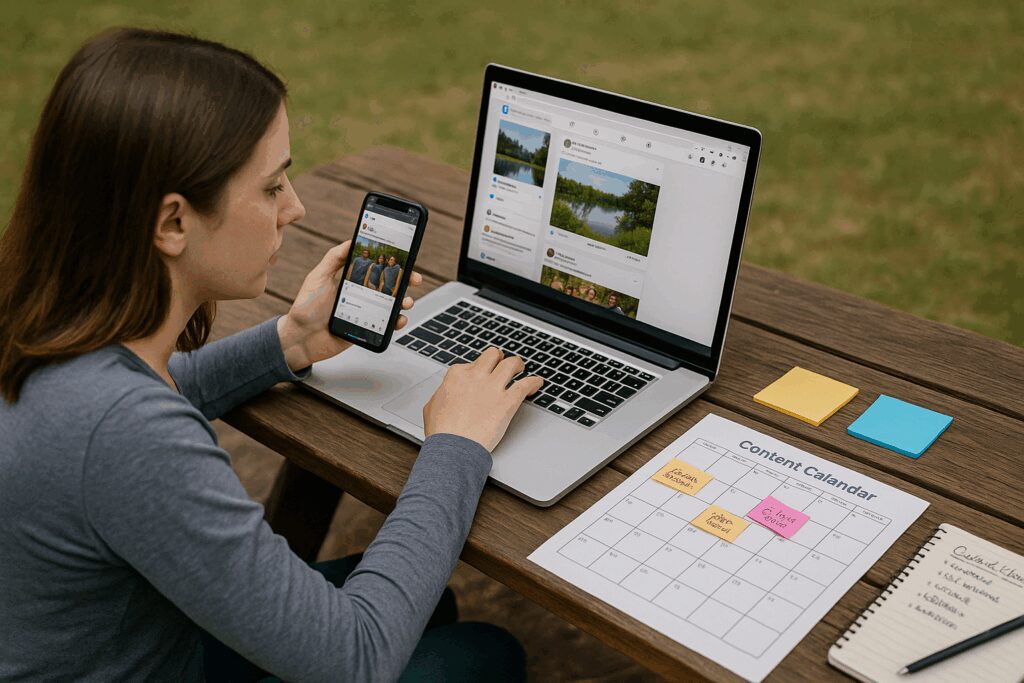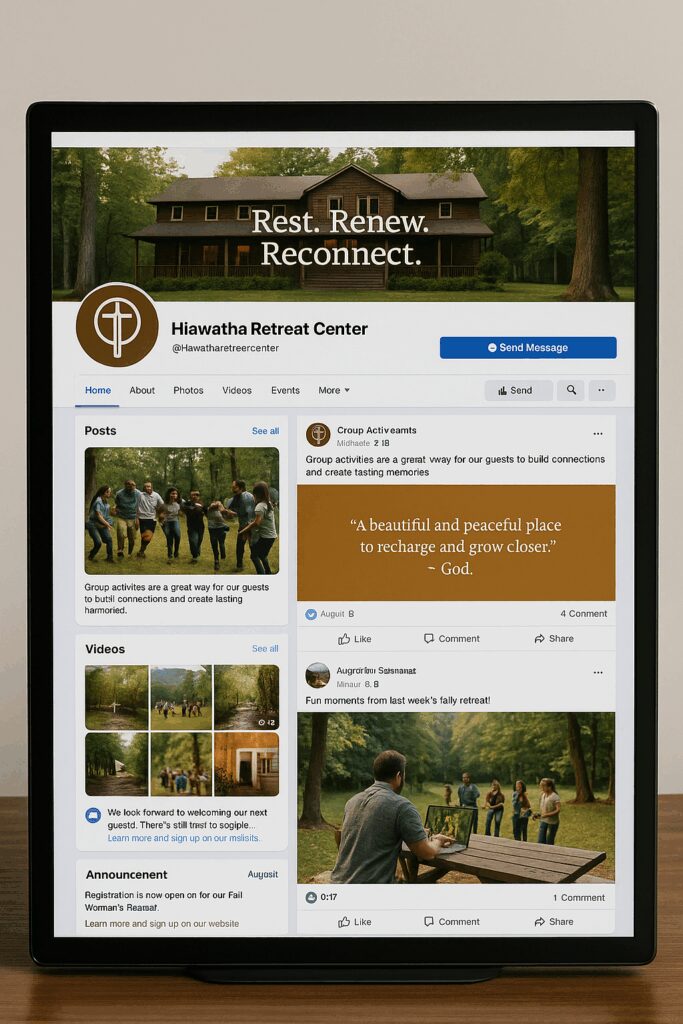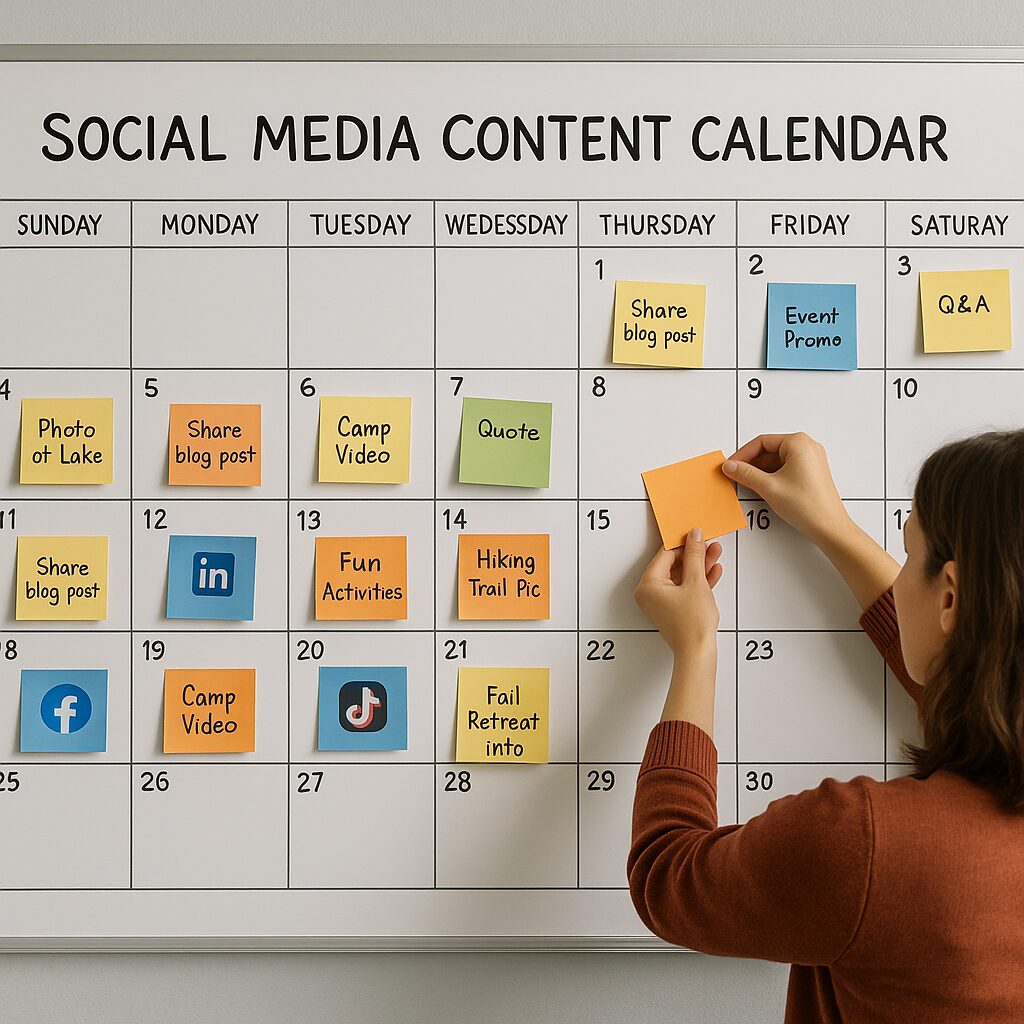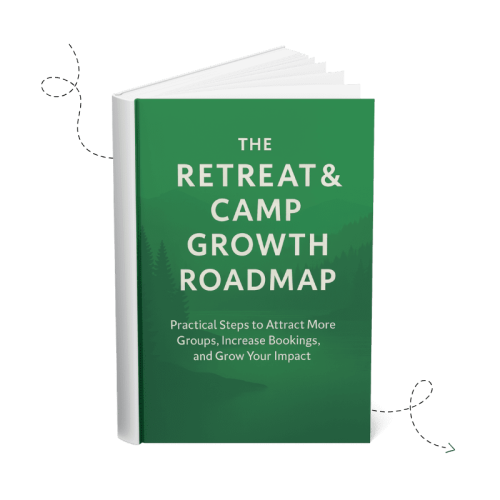Retreat & Camp Growth Roadmap Focus Area: Post Social Media Content
Introduction
Social media can feel like a noisy, crowded space, especially when you’re focused on ministry, hospitality, and running a retreat center or camp. But for Christian camps and retreats, a consistent social presence isn’t about chasing likes. It’s about nurturing relationships, serving your community, and staying visible to those you’ve already impacted.
In this article, you’ll learn how to build and maintain a meaningful presence on social media—one that deepens guest relationships, strengthens your brand identity, and keeps your ministry top of mind.
Why This Focus Area Matters
Executive leaders set the tone for how seriously your organization values connection and communication. When social media is treated as an extension of your ministry and not just a marketing task, it gets the clarity and consistency it needs to be effective. This doesn’t mean you need to post yourself—it means you help your team prioritize it appropriately.
Your camp or retreat center is more than a destination—it’s a place where lives are changed. Social media allows you to extend that experience beyond the time guests are on your grounds. It helps you maintain a connection with past guests, remind them of their time with you, and keep them engaged year-round.
A vibrant, engaging presence on platforms like Facebook and Instagram becomes an extension of your hospitality. It’s also a key form of digital stewardship: by showing up consistently, you demonstrate reliability, passion for your mission, and a commitment to community.
While organic social media isn’t primarily a lead generation tool, it plays an important supporting role in increasing brand awareness and credibility—both of which influence future inquiries and bookings. These are foundational elements of effective christian camp marketing and essential to long-term retreat center growth.
Is This an Area You Need to Focus on Right Now?
Take a moment to reflect on your current social media presence:
- Are we regularly posting to our social media platforms?
- Do our posts reflect our mission and provide value to our followers?
- Are we engaging with people who like, comment, or share our content?
- Is our content a healthy mix of inspiration, information, and invitations?
- Are we using content we already have to keep our feed fresh?
If you answered “no” to any of these, this focus area can help you bring greater clarity, alignment, and impact to your outreach.
Putting This Focus Area into Practice
Choose the Right Platforms for Your Audience
Not every social media platform serves the same purpose. If you’re reaching parents and church leaders, Facebook will likely be your primary platform. For visual storytelling and youth engagement, Instagram offers the most traction. LinkedIn might serve you well if you’re trying to connect with pastors or professional event planners. And TikTok, while optional, may be worth exploring if you serve younger demographics and have the resources to consistently create video content.
Rather than trying to do everything, start with the one or two platforms that match your primary audiences and do them well. As you grow, you can expand to others. This strategic restraint is an example of good stewardship—focusing your energy where it will matter most.
By being intentional about where you show up, you also ensure your messaging stays consistent and manageable, which supports sustainable retreat center marketing strategies.
Build a Branded, Trustworthy Presence
First impressions matter—especially online. A social media profile is often the first place a curious guest or group leader will land after hearing about your center. Make sure your profile photo, cover image, and bio all reflect your ministry’s personality and purpose. Your tone should match the experience someone would have at your camp or retreat—warm, trustworthy, and mission-aligned.
Include clear descriptions of what you offer and who you serve. Add your website, contact information, and even your booking inquiry link if possible. Think of your profile as your digital front porch—welcoming, well-kept, and ready to receive visitors.
Once you’ve established this foundation, every post you share reinforces it. This steady, trustworthy presence serves your long-term goals—by building recognition, deepening relationships, and encouraging both return visits and word-of-mouth referrals. That consistency builds recognition and trust, which are both crucial in effective retreat center marketing strategies.
Plan a Balanced Content Strategy
Social content isn’t just about promotion—it’s about conversation and community. One helpful approach is to balance your posts with three main types of content:
- Inspirational & Relational Content: This includes guest quotes, Scripture verses paired with retreat images, team devotionals, or encouraging messages. These posts remind people why your space matters.
- Informational Content: Share blog posts, FAQs, behind-the-scenes looks at your facilities, or highlights from your programs. These educate your audience and help them envision their next visit.
- Promotional Content: Occasionally share announcements, upcoming availability, or special offers. Always tie it back to your mission and avoid sounding salesy.
This mix helps you stay present in your audience’s feed without overwhelming them with booking requests. The goal is relationship first, with calls to action woven in naturally.

Create a Posting Rhythm That Works for You
You don’t need to post every day to be effective. Two to three times a week is plenty for most retreat centers, as long as you’re consistent. Many teams find it helpful to choose “content themes” for each day—like posting a guest memory on Mondays, a devotional thought on Wednesdays, and a group spotlight or promo on Fridays.
Use free scheduling tools like Meta Business Suite or Buffer to prepare posts in advance. This allows you to stay visible without becoming reactive or overwhelmed. During slower seasons, set aside time to batch-create content for the coming weeks.
Having a rhythm creates reliability. When your audience knows what to expect, they’re more likely to engage and stay connected—which builds long-term community and trust.
Engage Actively and Authentically
Think of social media engagement like campfire conversation. If someone comments on a post, take the time to respond. It doesn’t have to be elaborate—a simple “Thanks for coming!” or “Hope to see you next season!” goes a long way.
Respond to messages promptly and helpfully, just like you would answer the phone or welcome someone at your front desk. The more responsive and genuine you are, the more trust you build. If you don’t have capacity to monitor your accounts daily, assign someone to check in every few days or set up notifications for key interactions.
Treat every comment, question, or share as an opportunity for ministry. People remember how you made them feel—and often, those little moments online are what lead to repeat visits and referrals.
Leverage & Repurpose Existing Content
You don’t need to constantly create new content. Start by looking at what you already have. Do you have photos from recent groups? A blog post or devotional written by your staff? A kind review from a past guest? Each of these can be turned into a meaningful post.
For example, a single photo can be used to tell a guest story, highlight a particular activity, or introduce a staff member. If you host multiple events, build a content bank of images and quotes that can be used throughout the year. And don’t hesitate to ask guests if you can share their photos or feedback—they’re often honored to be featured.
Repurposing content saves time and strengthens your messaging. Over time, it becomes easier to build a rhythm and extend the impact of your existing efforts.
Create a Simple Content System
Many retreat centers struggle with social media simply because they don’t have a system. A basic content calendar can reduce decision fatigue. Choose a few content categories—like testimonials, team updates, event photos, spiritual encouragement—and rotate between them.
This structure helps you stay fresh without starting from scratch each time. During less busy weeks, you can create a month’s worth of posts in one sitting, schedule them, and then spend your energy engaging rather than scrambling. Keeping this organized is a best practice for any christian camp digital marketing strategy.
A system gives your team clarity and confidence, which means your efforts will be more consistent and impactful.

Optional Paid Boosting
While organic content should be your primary focus, there are moments when boosting a post makes sense. For instance, if you post about an upcoming event or a new offering and it gets good initial engagement, you can boost it to reach more people in your local area or within specific interest groups.
Keep budgets small and goals clear. You’re not trying to reach everyone—just more of the right people. Boosting works best when it complements a strong organic presence.
If boosting posts starts to feel like your main strategy, it’s time to revisit your content and audience fit. Your organic content is the fuel that powers your paid campaigns. When your everyday posts reflect your mission and engage your audience, your ads perform better—and feel more authentic. More advanced advertising tactics are covered in the “Launch Social Media Ads” focus area.
Resourcing Your Social Media Management
Ideally, your social media is managed by someone who understands your mission and is excited to share it with the world. They don’t need to be a professional marketer, but they should be reliable, creative, and comfortable with basic digital tools.
Many retreat centers have found success by empowering a younger staff member, a part-time communicator, or even a former guest who volunteers. If internal capacity is limited, you might explore working with a ministry-minded freelancer or agency—but even then, internal insight and oversight are key to staying authentic.
Whether internal or external, the person managing your social content should understand your audience, your voice, and your goals. Compared to other marketing channels, organic social media is one of the most cost-effective ways to maintain awareness and build trust with your audience. With just a few hours a week from the right person, you can stay connected with thousands of past and future guests. When they do, social media becomes more than a task—it becomes a true extension of your ministry.
Tools for Planning, Scheduling, and Analyzing Social Media Posts
Staying consistent on social media takes intentionality—but it doesn’t have to be complicated. One of the best ways to simplify your efforts is by using a social media management tool. These platforms allow you to schedule posts in advance, monitor engagement, and analyze performance, all from one place.
Popular options like Hootsuite, Buffer, and Sprout Social are trusted by nonprofits and ministries alike. They let you manage multiple platforms, plan content visually using calendars, and even monitor how your audience responds to different types of posts. If your team struggles to post consistently or coordinate content, these tools can be game changers.
If your retreat center is already using a customer relationship management (CRM) platform like HubSpot or LeadHub CRM, you may already have access to social media features built in. These integrations help you connect social engagement with inquiry tracking and follow-up—so you can see how online conversations contribute to bookings and long-term relationships.
At Improve & Grow, we use LeadHub CRM for our own social media planning. It’s affordable, integrates with other digital marketing efforts, and includes AI-powered content generation to help overcome writer’s block. For most retreat centers, it’s a practical and mission-aligned option for managing social outreach without adding to your team’s workload.
Social Media Content Planning Worksheet
To help you get started, we’ve created a worksheet that includes sample content themes, a fillable monthly calendar, tips for platform-specific engagement, and an easy checklist to track responses and follow-up.
📥 Download the Social Media Content Planning Worksheet
This tool is designed to bring structure and simplicity to your social efforts. Whether you’re just starting or looking to improve, the worksheet can help you stay focused, consistent, and aligned with your mission-driven goals.

Mini Case Study
One retreat center we’ve worked with for over a decade has embraced many of the social media practices outlined in this article—and the results speak for themselves. When we first partnered with them, their Facebook following was under 3,000. Today, they have grown that audience to over 24,000 followers. In that same time, they launched an Instagram profile that now has nearly 3,000 followers, all organically grown through consistent, local-focused content.
Their Facebook and Instagram content primarily promotes outdoor activities, seasonal events, and special offers. However, they also regularly highlight their retreat and day event offerings, using a mix of photos, video reels, guest stories, and team updates. Over time, they added a LinkedIn page to reach group planners at schools, churches, and companies—and tailored content there to emphasize retreats, team-building programs, and school field trips.
Their team sees regular engagement turn into inquiries and bookings, especially for their public adventure programs. They’ve also invested in boosting high-performing posts and running well-targeted social ad campaigns—resulting in a strong return on ad spend. The success of their approach is made possible by combining internal and external resources, a commitment to fresh photo and video content, and creative promotional strategies. Today, their brand is widely recognized in their region, and their social media presence has helped solidify their reputation as both a fun, high-quality adventure destination and a trusted ministry partner.
Putting It All Together
You don’t need to be everywhere or post constantly. You just need to show up consistently, be real, and offer value. Social media is another tool in your ministry toolbox—a way to extend your hospitality and invite people deeper into relationship with your mission.
Here are five practical ways to begin:
- Refresh your social media profiles with clear, current information.
- Choose one platform and commit to posting 2–3 times per week.
- Select three content types you can rotate through easily.
- Schedule a planning session to build your next month of posts.
- Make it someone’s clear responsibility to post and engage.
When you approach social media as ministry, not just marketing, your presence becomes a place of connection—and that connection often leads to return visits, referrals, and long-term support. The groups you’ve already served still care about your mission—they just need a reminder. Social media gives you the chance to keep that connection alive. In a digital world, showing up online is a form of stewardship, too.
Ready to Take the Next Step?
Staying active on social media helps you extend hospitality beyond your physical space. It nurtures real relationships, increases visibility, and reflects your mission online.
If you found this helpful, here are four great next steps to continue your journey:
🧭 Move to the Next Focus Area: Automate Review Requests
Learn how to use review request automations to increase 5-star reviews and generate referrals.
[Read Automate Review Requests Focus Area Article]
📘 Download the Retreat & Camp Growth Roadmap eBook
Get the full 3-stage system we use to help retreat centers and camps grow with clarity and purpose.
[Download the eBook]
🌱 Learn More About How We Help Retreat Centers & Camps
We’re a Christian-owned digital marketing agency that helps retreat centers and camps grow attendance, bookings, and impact through practical strategies rooted in clarity and stewardship.
[See How We Can Help]
🤝 Schedule a Free Discovery Call
Want help applying this to your unique situation? Let’s talk. We’ll explore where you are now, where you want to go, and how to take the next faithful step.
[Book a Discovery Call]
You don’t have to figure this out alone. Let’s build something meaningful—together.
Frequently Asked Questions
How often should we post to our social media?
Start with 2–3 posts per week. This strikes a good balance between visibility and manageability. If that feels like too much, start with once a week and build from there as your rhythm improves.
What kind of content gets the most engagement?
Photos of people, heartfelt testimonials, and behind-the-scenes glimpses tend to perform best. People respond to authenticity and stories—anything that helps them picture themselves in your environment is likely to resonate.
Should we be on TikTok?
Only if your team has the time, creativity, and consistency to produce video content—and your target audience includes youth. TikTok can be effective for some ministries, but it’s optional and can drain resources if not well-aligned with your strategy.
How do we turn a retreat photo into a post?
Pair it with a guest quote, Scripture, or story from that event. Add a question or reflection prompt to invite engagement. Always secure permission if the photo includes identifiable guests, especially minors.
How do we find the right person to manage social media?
Look for someone who is relational, creative, and aligned with your mission. They don’t need to be a marketing pro but should understand your audience and be consistent. Internal staff or volunteers often bring the most authentic voice.
What’s the difference between a post, story, and reel?
Posts are permanent and best for key updates or announcements. Stories are temporary and great for casual, real-time moments. Reels are short, engaging videos that often have greater reach. Use each as your capacity allows.
Should we reply to every comment?
Yes, as much as possible. Replies build relationships and show your audience that you care. It’s a form of digital hospitality that reinforces your mission.
Can social media really help us retain guests?
Absolutely. Social media keeps you present in people’s minds. By showing up consistently with meaningful content, you remind guests why they loved their time with you—and give them a reason to return.
What if someone posts something negative on our page?
Respond calmly and professionally. Acknowledge their concern, offer to resolve it offline if needed, and avoid defensiveness. How you respond says as much about your ministry as your positive posts do.
When should we consider boosting a post?
If a post is performing well organically and ties to an upcoming event or announcement, boosting it can increase your reach. It’s a low-risk way to extend visibility—but should support, not replace, a consistent organic strategy.
How can we simplify planning and scheduling our social media posts?
Using a social media management tool is one of the easiest ways to stay consistent and organized. Platforms like Hootsuite, Buffer, and Sprout Social let you schedule posts ahead of time and review how they perform. If you’re already using a CRM like HubSpot or LeadHub CRM, you may be able to manage your posts right from within your system. At Improve & Grow, we prefer LeadHub CRM for its low cost, built-in AI content tools, and seamless integration with lead tracking and booking workflows.





